Stone carving is a major craft of Odisha. As is evident from the innumerable archeological monuments, rock -cut sculptures, caves and temples built for centuries with the most beautiful carved statues and other adornments, the art of carving in stone has reached dizzy heights of excellence perfected over the centuries in Odisha. The artisans who built the magnificent temples of Puri and other wonders in stone, like the temple chariot of the Sun God at Konark and the beautiful stupas, have kept alive the sculptural traditions of their forefathers and their deft hands can chisel and carve exact replicas of the original temple sculptures besides producing a variety of other items.

Soapstone: Mainly soapstone or ‘khadipathara’ is used as a raw material here. Soapstone is available in Rajasthan, Madhya Pradesh, Odisha, Tamil Nadu, Karnataka and Bihar. The original white sandstone was found in Banki, a town in the Khurda district, Odisha. But due to its limited availability, craftsmen started using other varieties of soapstone from different parts of Odisha. This quality of stone is not as soft and lustrous. These are available in different colors like green and pink and are little harder than the original soapstone. The craftsmen handle with equal facility the ultra-soft white soapstone or khadipathara, the slightly harder greenish chlorite or Kochilpathara, the still harder pinkish Khandolite or Sahanapathara or Baulapathara and the hardest of all--black granite or Mugunipathara.
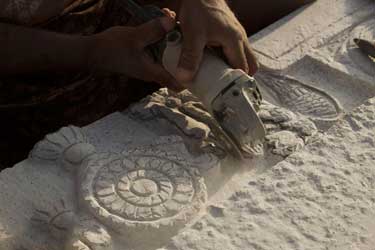
Araldite: Araldite is used to stick the broken pieces together. It is available in the market and is mixed with lamp soot for use.
Wax Polish and Varnish: These are used for shining the finally carved pieces.
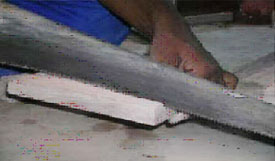
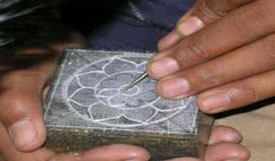
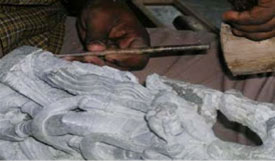
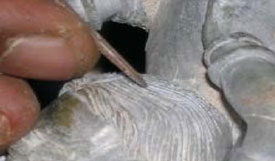
1. Process of making soapstone sculptures or products start with cutting a piece of soapstone in the required shape and size with the help of a saw. Sometimes the slab of stone is planed from the sides; this depends on the use ofthe stone slabs.
2. The sides are checked for being planed properly by putting a previously planed stone over the current one.
3. Whether the stone is hard or soft, a sort of outline is first drawn on it after it has been cut to the appropriate size.
3. Once the outline is incised, the final figure is brought out by removing the unwanted material. The taagi is then used to scrape off the unwanted material to give the stone a rough shape of the desired figure.
4. After that, the gunati is used for chiseling and detailing to give the final shape and touches to the object.
5: Then sandpaper (80-120-00 number) is used to smoothen the rough parts of the statue.
6. While scraping, the dust collected on the object has to be cleaned. The same is done with the help of a reasonably thick brush. A blow pipe is used for cleaning where the brush cannot reach, through which air is blown to clean the dust.
7. Carving is started by giving shape to the body and then others parts like face, fingers, nails and other minute details are carved out after completing the whole sculpture. In the end, the polishing is done depending on the nature of the product required.
8. If some piece of stone breaks while carving it is stuck with araldite.
9. The process can be summed up as seeing a piece of stone transform into a carved statue.